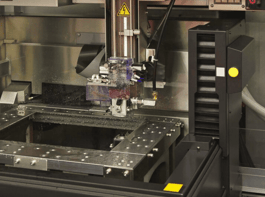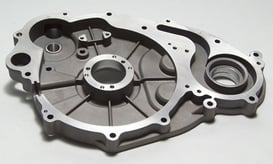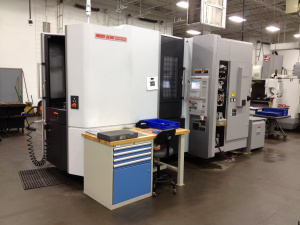One need only look at the past several decades to see that while the United States remains one of the world’s biggest manufacturing powerhouses, we’ve fallen behind a fair bit.
 Thirty years ago, one by one, manufacturers who dealt in bulk production of things like electronics and toys made the critical decision to reconfigure their operations in places like China’s Pearl River Delta, Singapore, the Philippines, or Mexico. As a result, the total percentage of our workforce that is employed directly or in a field related to manufacturing has declined steadily since the late 70s, to a point where it now constitutes roughly 9% of American workers. Compare this statistic to the boomtown heydays of the early 1950s when around 30% of our workforce was engaged in manufacturing, and you can see the great disparity. Cheaper workers, more permissive labor laws, and certain aspects of free trade agreements have all contributed to a culture and atmosphere where it is deemed “smart” – and justifiably so – for a large company to migrate its manufacturing capacities overseas. Few companies have used the productivity of foreign workforces more brilliantly than California’s Silicon Valley technology companies, where outsourcing of printed circuit boards and silicon chips has gone on since at least the 1980s.
Thirty years ago, one by one, manufacturers who dealt in bulk production of things like electronics and toys made the critical decision to reconfigure their operations in places like China’s Pearl River Delta, Singapore, the Philippines, or Mexico. As a result, the total percentage of our workforce that is employed directly or in a field related to manufacturing has declined steadily since the late 70s, to a point where it now constitutes roughly 9% of American workers. Compare this statistic to the boomtown heydays of the early 1950s when around 30% of our workforce was engaged in manufacturing, and you can see the great disparity. Cheaper workers, more permissive labor laws, and certain aspects of free trade agreements have all contributed to a culture and atmosphere where it is deemed “smart” – and justifiably so – for a large company to migrate its manufacturing capacities overseas. Few companies have used the productivity of foreign workforces more brilliantly than California’s Silicon Valley technology companies, where outsourcing of printed circuit boards and silicon chips has gone on since at least the 1980s.

 We had refrigerators, microwaves, toasters, dishwashers, and washing machines that made the daily schlep of food storage, cooking, cleaning, and grooming into something less than a footnote in our collective day. And as our country came online throughout the 90s and the 00s, we found ourselves living in a world where everything – information, consumer products, skills, career opportunities, professional consultation, friendship, even soul mates – were suddenly ours for the Google-searching. In a few brief years, the work of Tim Berners-Lee and his like grew to encompass the entire planet. People once marveled that a supersonic Concorde passenger jet could deliver travelers from Charles De Gaulle Airport to JFK Airport in a matter of a few hours. Today, these same people can connect with friends, loved ones, and business associates across the globe in the matter of just a few, wireless seconds.
We had refrigerators, microwaves, toasters, dishwashers, and washing machines that made the daily schlep of food storage, cooking, cleaning, and grooming into something less than a footnote in our collective day. And as our country came online throughout the 90s and the 00s, we found ourselves living in a world where everything – information, consumer products, skills, career opportunities, professional consultation, friendship, even soul mates – were suddenly ours for the Google-searching. In a few brief years, the work of Tim Berners-Lee and his like grew to encompass the entire planet. People once marveled that a supersonic Concorde passenger jet could deliver travelers from Charles De Gaulle Airport to JFK Airport in a matter of a few hours. Today, these same people can connect with friends, loved ones, and business associates across the globe in the matter of just a few, wireless seconds. Time and again in recent decades, American air supremacy has won the day in conflicts such as the First and Second Gulf Wars, as well as in Kosovo and Afghanistan. The names of America’s fighters, bombers, attack, recon, electronic detection, and transport aircraft are the stuff of late 20th and early 21st century legend: F-15s, F-16s, F-18s, C-5s, C-130s, A-10s, B-1s, B-2s, and B-52s have struck fear in the hearts of America’s enemies and have been “welcome news” indeed for many an American army or marine grunt pinned down by enemy gunfire in cities, villages, plains, and crevices across the Middle East and beyond.
Time and again in recent decades, American air supremacy has won the day in conflicts such as the First and Second Gulf Wars, as well as in Kosovo and Afghanistan. The names of America’s fighters, bombers, attack, recon, electronic detection, and transport aircraft are the stuff of late 20th and early 21st century legend: F-15s, F-16s, F-18s, C-5s, C-130s, A-10s, B-1s, B-2s, and B-52s have struck fear in the hearts of America’s enemies and have been “welcome news” indeed for many an American army or marine grunt pinned down by enemy gunfire in cities, villages, plains, and crevices across the Middle East and beyond. In the early 1980s, when then-President Ronald Reagan called for a “600 ship navy” to counteract the menace of a steadily growing Soviet fleet of submarines and maritime bombers – we put our shoulders to the wheel to meet that challenge. The American Navy saw its largest incarnation since the end of the Second World War, and was indisputably the most powerful fleet that ever sailed an ocean. As the Cold War ended and the so-called Pax Americana began, we thought the time had come to begin shifting our efforts into other advanced fields of technology, areas like computers, advanced medicine, and space-borne telecommunications systems.
In the early 1980s, when then-President Ronald Reagan called for a “600 ship navy” to counteract the menace of a steadily growing Soviet fleet of submarines and maritime bombers – we put our shoulders to the wheel to meet that challenge. The American Navy saw its largest incarnation since the end of the Second World War, and was indisputably the most powerful fleet that ever sailed an ocean. As the Cold War ended and the so-called Pax Americana began, we thought the time had come to begin shifting our efforts into other advanced fields of technology, areas like computers, advanced medicine, and space-borne telecommunications systems. In their daily goings-about at General Mills, Del and Loren observed – and astutely so – that the machinery they operated at the company’s plants could be built from higher-quality components. After some negotiations with the parent company, they began fabricating machined parts for General Mills in 1967. Other commercial customers followed in swift succession. In the 1980s, with the massive build-up of the United States Navy to counter the perceived threat of the Soviet Red Banner Fleet, Ardel became a critical provider of high-grade components for U.S. naval warships. Our work on behalf of the U.S. Navy played its fair share in helping America out-engineer and outspend the Kremlin in terms of defense, and allowed for the Cold War to finally – and peacefully – end.
In their daily goings-about at General Mills, Del and Loren observed – and astutely so – that the machinery they operated at the company’s plants could be built from higher-quality components. After some negotiations with the parent company, they began fabricating machined parts for General Mills in 1967. Other commercial customers followed in swift succession. In the 1980s, with the massive build-up of the United States Navy to counter the perceived threat of the Soviet Red Banner Fleet, Ardel became a critical provider of high-grade components for U.S. naval warships. Our work on behalf of the U.S. Navy played its fair share in helping America out-engineer and outspend the Kremlin in terms of defense, and allowed for the Cold War to finally – and peacefully – end. We’re not talking about the fact you have to pay for your “complimentary” audio headset on most flights these days. We’re talking about reducing the overall tonnage of airplanes in order for them to attain greater mechanical performance and efficiency.
We’re not talking about the fact you have to pay for your “complimentary” audio headset on most flights these days. We’re talking about reducing the overall tonnage of airplanes in order for them to attain greater mechanical performance and efficiency. Linear dimensioning is simply the practice of measuring a given distance to the most exact possible degree of accuracy.
Linear dimensioning is simply the practice of measuring a given distance to the most exact possible degree of accuracy. 